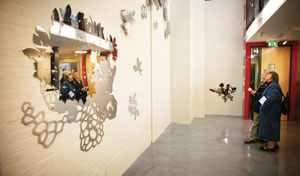United we stand
Tammy Bedford explains how two charities with very different charitable aims are learning to work hand in hand

In the reception area of the Old Fire Station in the heart of Oxford stands a large permanent art installation. Created by a group of homeless people working with artists Rachel Barbaresi and Emma Reynard, it was jointly commissioned by Arts at the Old Fire Station and Crisis Skylight Oxford. Entitled ‘Change – when patterns are broken, new worlds emerge’, the piece has come to symbolise what we are trying to do through a unique partnership: give homeless people new opportunities through creativity, provide profile and professional development to artists, and offer the public opportunities to engage with high quality art.
The Old Fire Station reopened in November 2011 following a £3.4m refurbishment. Launched as a new hub for creativity, entertainment and learning, it houses a café, auditorium, artists’ workspaces, dance studio, workshop spaces, gallery and a shop selling work by emerging and established artists. It provides space and activities for the public, for artists and for homeless people. Supported by Oxford City Council, the Old Fire Station is run jointly by two organisations: Arts at the Old Fire Station, a new charity and social enterprise, is responsible for the arts facilities and programme, while Crisis Skylight Oxford provides education, training and employment opportunities for homeless people. We have shared responsibility for the operation of the building and for creative initiatives involving Crisis clients. This is a permanent relationship, and although we are an independent body with a degree of choice over how we collaborate with Crisis Skylight Oxford, the issue of whether we collaborate is non-negotiable and a core part of our mission.
As a new arts organisation, this type of collaboration presents us with a number of issues and challenges. The first challenge is that of scale. Successful partnerships tend to be based on equality, but our organisations are anything but equal. Crisis Skylight Oxford is part of Crisis, a national charity which has been running for over 40 years and last year had a total income of £13.8m. Arts at the Old Fire Station was born in September 2010 and had a year one total income of £92k.
As trustees we are well aware of the potential for an unbalanced relationship with all the associated tensions – the ‘David and Goliath’ syndrome. We have managed to avoid this so far, partly through a strong sense of shared purpose and mutual respect, and a willingness to work through issues as they arise. The role of Oxford City Council has been important in providing leadership to the development of the Old Fire Station, and establishing a planning group which enabled each of the project partners, regardless of size,
to influence the process. It has also helped enormously that the national leadership of Crisis has been very visible and supportive, and one of the senior managers is now a trustee of Arts at the Old Fire Station.
The second issue relates to collaborating across sectors. As an arts organisation we know what we mean by participation and arts development. We are tuned in to the nuances of debates around process and product, access and quality and we ascribe specific meanings to words such as ‘commission’ and ‘creativity’. Our partner inhabits a very different world, and the issues around homelessness are similarly not our first language. This means that we each have to articulate exactly what we mean and what we expect from those joint endeavours. As our first shared project, the commission mentioned above involved discussions between the two organisations around definitions of quality, co-authorship and participation. We explored in some depth what our expectations and respective priorities were. It became evident that we had a shared view on the quality of experience for the participants and the quality of artistic outcome, and happily the project delivered on both counts.
This bridging of sectors has been helped in other practical ways. Our Board includes people with a range of experiences and specialisms, and while the arts are well represented, trustees with backgrounds in the voluntary, higher education and financial sectors bring perspectives that are relevant to our partner. Particularly important is the relationship between the staff of the two organisations. As well as a commitment at all levels to making this work, both organisations are led by people who have had some experience of each sector. Jeremy Spafford, Director of Arts at the Old Fire Station, and Kate Cocker, Director of Crisis Skylight Oxford, each have backgrounds which cross the arts and homelessness sectors and bring insights into their joint work.
This is early days for us, and we are still in our first year of operation. Every day brings new challenges and negotiations, and while our understanding of working collaboratively is growing, there is inevitably a healthy dose of ‘making it up as we go along’. The sense of joint endeavour, underpinned by the support of Oxford City Council, influences everything that we do and while we are realistic about the challenges we are also optimistic about our ability to rise to the occasion.
Join the Discussion
You must be logged in to post a comment.